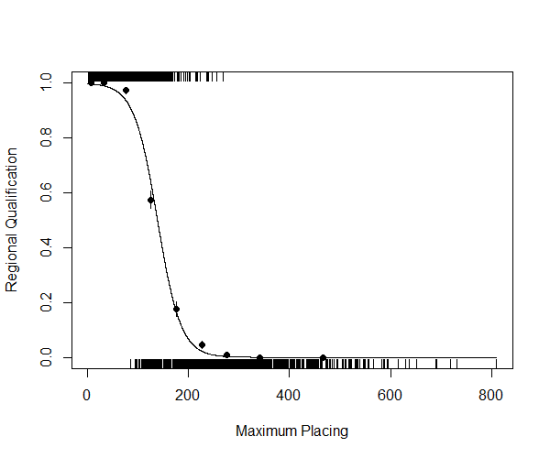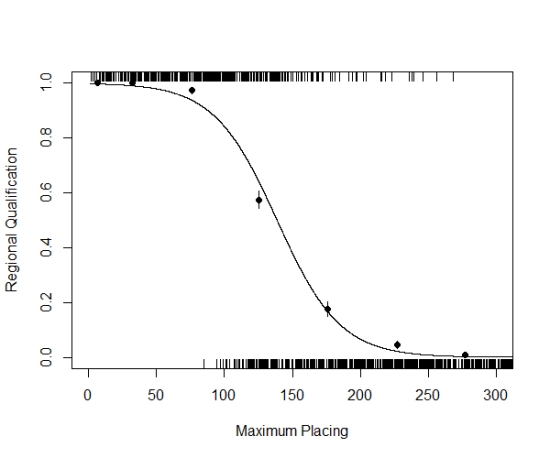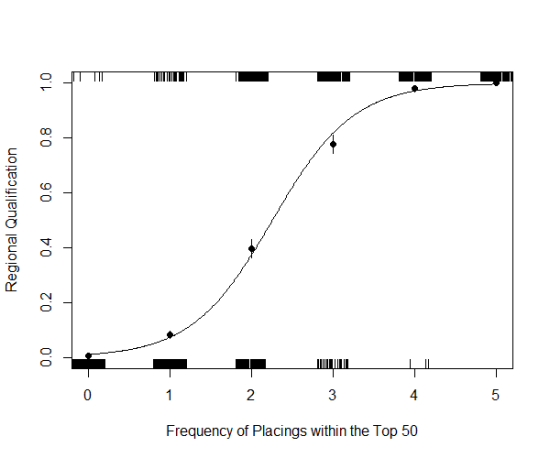Here’s another contribution to my analyses of the CrossFit Open competition, and is continued from here, where I looked broadly at maximum and minimum placings among Open competitors, and here, where I examined the frequency that athletes finished within the top 60 of a given Open workout and how that related to qualification for Regionals.
This particular post is an extention of my brief analysis examining probabilities of Regional qualification with top 50 finishes during the Open.
Remember
This post attempts to address (2): your chances of qualifying for Regionals with a particularly high Open placing.
I’m going to refer to “maximum placing” again, which seemed to cause some confusion in my past posts. Maximum is highest absolute value. For instance, 398th is a higher place than 2nd place. So, “maximum” is “bad” if you’re interested in competing.
I’ve got plots to present, and I will summarize them in the last paragraph of this post.
Past probabilities of qualifying based on maximum and minimum placings
So you’re interested in qualifying for Regionals, but 14.3 is a culmination of all of your weaknesses: triple-under, backflip, muscle-ups, while holding a perfect D-flat major. You compete, and finish as expected, but not to your liking. Do you still have a chance at qualifying?

Figure 1 is similar to what I presented in my previous post, but the x-axis has been replaced with Maximum Placing – the highest place value (remember, high is ‘bad’) an athlete received during a given Open competition.
Each little, vertical line represents one athlete, during one Open competition (1800 total), and it is placed on the bottom (y = 0) for non-regional qualifiers, and on the top (y = 1) for the Regional qualifiers. Where each line along the x-axis represents her maximum placing of the five workouts in a given Open.
Again, the curved line is what is interesting; more specifically, the rapid change illustrated by the curve. The line lets us estimate the chances of an individual qualifying for regionals, given a particular place in an Open workout – in this case, it’s the maximum place scored. As you move from a low maximum (<50th) to about 300th place, qualifying athletes drop dramatically. Let’s zoom in:

If we again follow the closed circles, which represent empirical probabilities that an athlete will qualify, athletes with a maximum placing below 50, have a 100% chance of qualifying, but those chances start dropping off quickly:
- 97% with maximums below 100th
- 57% with maximums below 150th
- 18% with maximums below 200th,
- 4% with maximums below 250th, and
- 0.09 % by the time we reach a maximum of 300th place.
Summary
This is exactly what I found in my first post – get a score above 300th place and you’ll be breaking records if you qualify for Regionals. It’s very unlikely that you have a shot at that point…. But, I need to emphasize the limits of my dataset. These ‘probabilities’ are not actually probabilities (more accurately, they are estimates of the contribution of maximum placing to regional qualification taken from fitted models to past data), and they only apply if you happen to be a women, in one of the five regions listed in the first post… during Open years 2012 and 2013.
So, take these data with a grain of salt. In fact, take them only as encouragement, and a push to do better next time. The data simply show what has occurred in past Open competition (there have only been two), and one of the mantras of CrossFit is to always push harder and surprise yourself. If you finish 301st in 14.2, make me recalculate my estimates and make new plots. (is that motivating to anyone?)

